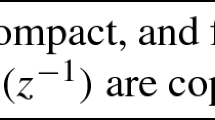Abstract
The static and the dynamic output pole placement problem belong to the prominent design problems of modern control theory and we refer to the survey articles [4, 10, 19, 21] where also more references to the literature are provided. Various facets of the pole placement problem attracted many researchers over the years. It was been recognized right at the beginning of the problem that the output pole placement problem is nonlinear in nature and a simple solution based on techniques from linear algebra cannot be expected. In recent years significant progress has been achieved. This progress is due in a major part to a better understanding of the system theoretic ingredients and its relation to algebraic geometry. Helpful in this regard is the behavioral approach which comes in its formulation closest to the algebraic geometric nature of the pole placement problem.
Supported in part by NSF grant DMS-96-10389.
Access this chapter
Tax calculation will be finalised at checkout
Purchases are for personal use only
Preview
Unable to display preview. Download preview PDF.
Similar content being viewed by others
References
I. Berstein. On the Lusternik-Šnirel’mann category of real Grassmannians. Proc. Camb. Phil. Soc., 79: 129–239, 1976.
V. Blondel. Simultaneous Stabilization of Linear Systems, volume 191 of Lecture Notes in Control and Information Sciences. Springer-Verlag London Ltd., London, 1994.
R. W. Brockett and C. I. Byrnes. Multivariable Nyquist criteria, root loci and pole placement: A geometric viewpoint. IEEE Trans. Automat. Control, AC-26: 271–284, 1981.
C. I. Byrnes. Pole assignment by output feedback. In H. Nijmeijer and J. M. Schumacher, editors, Three Decades of Mathematical System Theory, Lecture Notes in Control and Information Sciences, volume 135, pages 31–78. Springer Verlag, 1989.
C. I. Byrnes and B. D. O. Anderson. Output feedback and generic stabilizability. SIAM J. Control Optim., 22 (3): 362–380, 1984.
B. K. Ghosh. An approach to simultaneous system design, part II: Nonswitching gain & dynamic feedback compensation by algebraic geometric methods. SIAM J. Control Optim., 26 (4): 919–963, 1988.
W. Helton, J. Rosenthal, and X. Wang. Matrix extensions and eigenvalue completions, the generic case. Trans. Amer. Math. Soc., 349 (8): 3401–3408, 1997.
N. Karcanias and C. Giannakopoulos. Grassmann invariants, almost zeros and the determinantal zero, pole assignment problems of linear multivariable systems. Internat. J. Control, 40 (4): 673–698, 1984.
J. Leventides and N. Karcanias. Global asymptotic linearization of the pole placement map: A closed form solution for the constant output feedback problem. Automatica, 31 (9): 1303–1309, 1995.
N. Munro. Pole assignment: A review of methods. In M. G. Singh, editor, Systems and Control Encyclopedia, pages 3710–3717. Pergamon Press, 1990.
M. S., J. Rosenthal, and X. Wang. On generic stabilizability and pole assignability. Systems & Control Letters, 23 (2): 79–84, 1994.
M. S. Ravi, J. Rosenthal, and X. Wang. On decentralized dynamic pole placement and feedback stabilization. IEEE Trans. Automat Contr., 40 (9): 1603–1614, 1995.
M. S. Ravi, J. Rosenthal, and X. Wang. Dynamic pole assignment and Schubert calculus. SIAM J. Control Optim., 34 (3): 813–832, 1996.
J. Rosenthal. On dynamic feedback compensation and compactification of systems. SIAM J. Control Optim., 32 (1): 279–296, 1994.
J. Rosenthal, J. M. Schumacher, X. Wang, and J. C. Willems. Generic eigenvalue assignment for generalized linear first order systems using memoryless real output feedback. In Proc. of the 34th IEEE Conference on Decision and Control, pages 492–497, New Orleans, Louisiana, 1995.
J. Rosenthal, J. M. Schumacher, and J. C. Willems. Generic eigenvalue assignment by memoryless real output feedback. Systems & Control Letters, 26: 253–260, 1995.
J. Rosenthal and F. Sottile. Some remarks on real and complex output feedback. Systems & Control Letters, 33 (2): 73–80, 1998.
J. Rosenthal and X. Wang. Output feedback pole placement with dynamic compensators. IEEE Trans. Automat. Contr., 41 (6): 830–843, 1996.
J. Rosenthal and X. Wang. Inverse eigenvalue problems for multi- variable linear systems. In C. I. Byrnes, B. N. Datta, D. Gilliam, and C. F. Martin, editors, Systems and Control in the Twenty-First Century, pages 289–311. Birkäuser, 1997.
H. Schubert. Beziehungen zwischen den linearen Räumen auferleg¬baren charakteristischen Bedingungen. Math. Ann., 38: 598–602, 1891.
V. L. Syrmos, C. T. Abdallah, P. Dorato, and K. Grigoriadis. Static output feedback—a survey. Automatica, 33 (2): 125–137, 1997.
X. Wang. Pole placement by static output feedback. Math. Systems, Estimation, and Control, 2 (2): 205–218, 1992.
X. Wang. Grassmannian, central projection and output feedback pole assignment of linear systems. IEEE Trans. Automat. Contr., 41 (6): 786–794, 1996.
J. C. Willems. Paradigms and puzzles in the theory of dynamical systems. IEEE Trans. Automat. Control, AC-36(3): 259–294, 1991.
J. C. Willems. On interconnections, control, and feedback. IEEE Trans. Automat Control, 42 (3): 326–339, 1997.
J. C. Willems. Generic eigenvalue assignability by real memoryless output feedback made simple. A. Paulraj, V. Roychowdhury, and C.D. Schaper, editors, In Communications, Computation, Control and Signal Processing, Kluwer, pages 343–354, 1997.
J. C. Willems and W. H. Hesselink. Generic properties of the pole placement problem. In Proc. of the 7th IFAC Congress, pages 1725–1729, 1978.
Author information
Authors and Affiliations
Editor information
Editors and Affiliations
Rights and permissions
Copyright information
© 1999 Springer-Verlag London Limited
About this chapter
Cite this chapter
Rosenthal, J., Willems, J.C. (1999). Open problems in the area of pole placement. In: Blondel, V., Sontag, E.D., Vidyasagar, M., Willems, J.C. (eds) Open Problems in Mathematical Systems and Control Theory. Communications and Control Engineering. Springer, London. https://doi.org/10.1007/978-1-4471-0807-8_37
Download citation
DOI: https://doi.org/10.1007/978-1-4471-0807-8_37
Publisher Name: Springer, London
Print ISBN: 978-1-4471-1207-5
Online ISBN: 978-1-4471-0807-8
eBook Packages: Springer Book Archive




